How Abbott’s Newest Indication Is Reshaping Heart Failure Management
The company has won a new indication for the CardioMems Sensor to be implanted in NYHA Class II patients.
February 24, 2022

Abbott Laboratories’ CardioMems sensor is changing the way pulmonary arterial pressures are monitored and managed in heart failure patients. And now, with a recent nod from FDA, the CardioMems HF System has an indication that will allow it to reach an additional 1.2 million people living with heart failure.
The change in the paradigm can be summed up by rethinking the correlation between a heart failure patient’s pulmonary arterial pressure and symptoms said Philip Adamson, MD, CMO of Abbott's heart failure business.
“What we had discovered about people with heart failure was that their pressures were not in line with their symptoms,” Adamson told MD+DI. “… And the symptoms we see or the symptoms that patients incorporate into their life, that they don’t complain about, and the symptoms that we’re able to assess in a typical clinical encounter - may not reflect what’s happening under the hood.”
CardioMems sensor, which is about the size of a paper clip and placed in the pulmonary artery during a minimally invasive procedure, first won approval from FDA nearly eight years.
The system’s first indication was to monitor New York Heart Association Class III patients with a prior heart failure hospitalization within the last year. Data from the company’s GUIDE-HF trial paved the way for the new indication – which reaches patients NYHA Class II patients.
“The indication that came from GUIDE- HF includes Class II and Class III patients either with a previous hospitalization and or an elevation of natriuretic peptides,” he said.
Class II heart failure is generally categorized as mild heart failure where patients have a slight limitation with physical activity.
The GUIDE-HF trial included a randomized arm of 1,000 patients and a single arm of up to an additional 2,600 patients that are currently enrolling for a total of 3,600 patients across 118 centers in North America. All patients were implanted with a CardioMems sensor, but therapy for patients in the control arm was not guided by the device.
The study found that both Class II heart failure patients and patients with elevated natriuretic peptides were suggested to have better outcomes when their therapy was guided by pulmonary pressure monitoring, with a respective 34% and 25% reduction in heart failure hospitalizations, emergency visits, and death.
Results were presented at the ESC Congress 2021 (organized by the European Society of Cardiology) in August 2021 and simultaneously published in The Lancet.

The CardioMems sensor has a rich history that precedes its time under the auspices of Abbott Laboratories.
“This is a micro-electromechanical system which was initially designed to measure pressures in very hostile environments,” Adamson said. “In fact, this one was designed to measure pressures within the hostile environment of jet engines. MIT, the DARPA program, and Georgia Tech engineers that helped develop this worked to allow the process to have a medical application. So micro-electromechanical systems are ubiquitous almost in cellphones and automobiles – but in medical applications, this concept is kind of small, honestly.”
The technology was further developed by Atlanta, GA-based CardioMems. However, at the time of the sensor’s 2014 approval by FDA, CardioMems was in the process of being acquired by St. Jude Medical for $375 million. St. Jude went on to be acquired by Abbott for $25 billion nearly three years after the CardioMems deal closed.
About the Author(s)
You May Also Like



.png?width=300&auto=webp&quality=80&disable=upscale)
